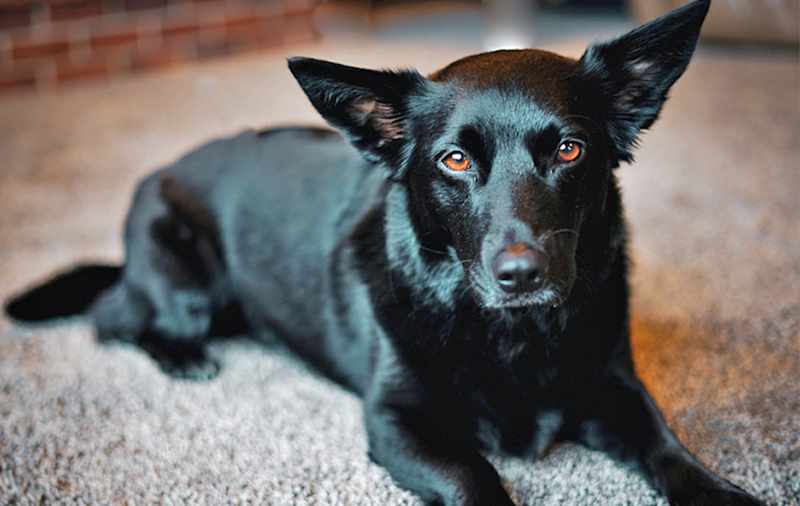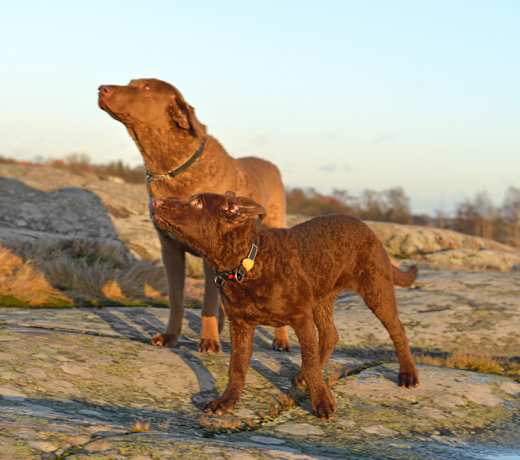Yes, Labradors have soft mouths. This means they can carry things gently without biting down hard, which was especially important in their original role as hunting dogs who retrieved game. Their soft mouth lets them bring back birds or other prey without causing damage. This trait also makes them great at carrying toys or even helping with tasks like fetching items for their people. Slipper delivery, anyone?
Labrador Retriever
Breed Type: Sporting
Common nicknames: Lab
Coat: Double
Hypoallergenic: No, they will likely trigger allergies.
Temperament: Friendly, gentle, intelligent, loyal
Life expectancy: 10-12 years
Color & patterns:

Labrador Retrievers, also known as “Labs,” have sweet temperaments, boundless energy, and incredible intelligence. With their friendly faces and wagging tails, it’s no wonder why they are one of the most popular dog breeds in the world. Labradors are a medium-to-large breed, with males typically weighing around 65 to 80 pounds and females around 55 to 70 pounds. They have a short, dense coat in three standard colors: yellow, black, and chocolate. Labs are famous for being excellent swimmers, which makes sense considering their roots as hunting dogs in Canada. Whether you’re looking for a running partner, a hiking buddy, or just a snuggly companion, a Lab is sure to fit the bill.
Labrador Retriever characteristics
Learn about about Labrador Retriever basics like their fur colors, shedding levels, how much grooming they need, and other Labrador Retriever facts.
Average height
21-24 inches (53.3-61.0cm)
Average weight
49-77 pounds (22.2-34.9 kg)
Average lifespan
10-12 years
Exercise needs
Grooming needs
Full-grown size
Good with cats
Good with kids
Training aptitude
How long do black Labradors live?
Black Labradors typically live 10 to 12 years. (This is similar to Labradors of other colors, like yellow and chocolate.) Their lifespan depends on factors such as genetics, diet, exercise, and regular vet care. Keeping them healthy and active can help them enjoy a longer life.
Do Labrador Retrievers have webbed feet?
Yes, Labrador Retrievers have webbed feet. This feature helps them swim efficiently, making them natural water dogs. The webbing between their toes acts like a paddle, giving them extra push and control in the water. It’s one of the reasons Labs are popular for water retrieving and rescue work.
Do Labradors shed more than Golden Retrievers?
Labradors and Golden Retrievers both shed quite a bit, but Golden Retrievers usually shed more because they have longer, thicker coats. Labradors have shorter double coats that still shed year-round, especially during seasonal changes. Golden Retrievers’ longer fur tends to shed more noticeably and can spread around the house more. Both breeds benefit from regular brushing to keep shedding under control.
Do black Labrador Retrievers shed?
Yes, black Labrador Retrievers shed. They have double coats — soft, insulating undercoats and water-resistant topcoats — which help protect them during different weather conditions. Shedding tends to be moderate year-round but can increase during seasonal changes in the spring and fall when they “blow” their coats. Regular brushing, about once or twice a week, can help manage the shedding and keep their coats healthy.
How big do Labrador Retrievers get?
Labrador Retrievers are considered a medium to large breed, with most weighing 55 to 80 pounds and standing around 22 to 24 inches tall. Some pups may fall outside this range, as genetics and factors like diet and exercise can influence their size. It’s important to monitor your Labrador's weight to ensure they maintain a healthy size throughout their life.
What colors do Labrador Retrievers come in?
Labrador Retrievers come in three primary coat colors: black, yellow, and chocolate. Each color is a solid, single shade without markings. Black is one of the most common coat colors for Labrador Retrievers. The yellow of Labs can range in color from pale cream to rich fox red, and, similarly chocolate Labs may have coats that range from light to dark chocolate brown.
Can you shave a Labrador Retriever?
No, shaving a Labrador Retriever is not recommended because it can permanently damage their coat by leading to uneven coat regrowth and leaving patches of uneven hair. While shaving might seem like a good idea to help a Lab stay cool, especially during the summer months, it also removes Labs’ natural insulation, making them more susceptible to heat stroke and putting them at risk of getting skin burns or skin cancer.
If you’re concerned about your Labrador Retriever overheating during hot weather, you can help keep them cool by providing plenty of indoor time, outdoor shade, fresh water, and a dog pool.
Do Labrador Retrievers shed?
Yes, Labrador Retrievers shed. Labradors are notorious for their shedding. These pups shed a moderate to heavy amount year-round due to their thick double coat. The outer layer is coarse and waterproof, while the inner layer is dense, fluffy, and super cozy. The inner layer, known as the undercoat, keeps Labradors warm – especially when swimming in cold water or during rainfall.
How long do Labrador Retrievers live?
Labrador Retrievers typically have a lifespan of 10 to 14 years, although individual dogs may live longer or shorter lives based on factors such as genetics, diet, exercise, and healthcare. Proper nutrition, regular veterinary check-ups, and a healthy lifestyle can contribute to helping Labrador Retrievers live longer, healthier lives.
What are the different types of Labrador Retrievers?
There are two types of Labrador Retrievers: American Labradors and English Labradors. While they are the same breed, there are some minor differences between the two. English Labs are stocky, have a broad head, and are generally calm companions, whereas American Labs are lighter, may have more energy, and be more suited to hunting.
Are Golden Retrievers Labradors?
No, Golden Retrievers and Labrador Retrievers are separate breeds. Although they share traits, such as being friendly and loyal, and are both retrievers primarily bred for retrieving waterfowl, they have distinct origins and characteristics.
When do Labrador Retrievers stop growing?
Labrador Retrievers typically reach their full height and physical maturity by around 12 to 24 months of age. It’s essential to provide proper nutrition, exercise, and healthcare during their growth stages to ensure they develop into healthy adult dogs. Regular veterinary check-ups can also help monitor their growth and overall well-being.
Are Labrador Retrievers hypoallergenic?
No, Labrador Retrievers are not considered hypoallergenic. Labrador Retrievers have a double-layered coat that can shed heavily, and they can produce allergens in their skin cells, saliva, and urine, similar to most other dog breeds that can trigger allergic reactions in sensitive individuals.
Labrador Retriever health
Learn about about the Labrador Retriever health outlook and what diseases they may be prone to at various stages of their life.
Do Labs sleep a lot?
As a high-energy, high-endurance breed, Labrador Retrievers don’t tend to sleep a lot. An adult Lab may get about 12 to 14 hours of sleep and is less likely to nap frequently throughout the day. Additionally, these high-energy pups may have a hard time settling down at night if they don’t get enough exercise and enrichment during the day.
Should you shave a Labrador?
No, you should not shave a Labrador. Their double coat is designed to protect them from both heat and cold, as well as sunburn and skin irritation. Shaving a Lab removes this natural insulation and can actually make it harder for them to regulate their body temperature.
Instead of shaving, stick to regular brushing — especially during shedding seasons — to remove loose hair and keep their coat healthy. Brushing a few times a week helps control shedding and supports good skin health without compromising their natural protection. If you’re dealing with extreme shedding or matting, a visit to a professional groomer is a better choice than using clippers yourself.
What size dog crate do you need for a Labrador?
For an adult Labrador Retriever, you’ll need a large dog crate that measures about 42 inches long, 28 inches wide, and 30 inches high.
This size provides most adult Labs with enough room to stand up, turn around, and lie down comfortably. If your Lab is especially large (more than 90 pounds or very tall), you might want to size up to a 48-inch crate.
If you’re crate-training a Labrador puppy, you can start with a full-size crate and use a divider panel to adjust the space as they grow. This helps avoid accidents and gives your pup just enough room while they’re learning to become house-trained.
Are Labradors allergic to chicken?
Labradors aren’t inherently allergic to chicken, but individual Labs can develop a food allergy or sensitivity to chicken, as with any other protein. Signs of a chicken allergy can include itching, skin issues, digestive upset, or ear infections. If a Labrador exhibits these symptoms, a vet might recommend an elimination diet to pinpoint the problem. Many Labs eat chicken without any issues, but if allergies are a concern, pet parents can try alternative protein sources.
How often should you bathe a Labrador?
Most Labradors only need a bath every one to two months, or when they get especially dirty or smelly. Their double coat is water-resistant and naturally helps repel dirt, so frequent bathing can strip the oils that keep their skin and coats healthy.
If your Lab has skin issues, allergies, or rolls in something gross (they’re pretty good at that), you can bathe them more often using a gentle, dog-safe shampoo. In between baths, brushing once or twice a week can help manage shedding and keep their coat looking clean.
How much exercise does a Labrador need?
Labrador Retrievers need at least one to two hours of exercise each day. They’re a high-energy athletic breed built for activity, especially when they’re young. Without enough physical and mental stimulation, Labs can become bored — and a bored Lab often turns to digging, chewing, or other destructive habits.
Their daily exercise should include walks, playtime, and mentally engaging activities, such as fetch, scent work, or training sessions. Swimming is also a great option as most Labs are dogs who love water. Regular exercise keeps them physically fit, mentally sharp, and much easier to live with.
Do Labrador Retrievers need to be groomed?
Yes, Labrador Retrievers require regular grooming to keep their coat healthy and reduce shedding. While these pups do not require a high-maintenance grooming routine, they still require the occasional bathing and frequent brushing to keep the shedding at bay. Regular nail trimming, ear cleaning, and dental care are also essential for their well-being.
Do Labrador Retrievers have health issues?
Labrador Retrievers are generally healthy dogs, but they are prone to a few health issues, including:
Hip and/or Elbow Dysplasia: Hip and elbow dysplasia are two of the most common skeletal diseases seen in dogs. They are similar diseases in which either the hip or elbow joint has grown abnormally or is misshapen. The abnormal shape prevents the joints and sockets from adequately meeting one another, resulting in rubbing and grinding instead of sliding smoothly.
Patellar luxation: Also known as slipped kneecaps, patellar luxation is a common problem in many dog breeds. It occurs when slight abnormalities cause the knee joint to slide in and out of place, and can cause pain and occasional lameness. Surgical treatment is available for severe cases, although many dogs lead normal lives without treatment.
Portosystemic Liver Shunt: Portosystemic shunt (PSS) is a hereditary issue that obstructs proper blood flow to the liver. Since the liver is responsible for detoxifying the body, PSS sends the toxins in unfiltered blood to the heart, brain, and other body parts. Signs can include, but are not limited to, behavioral changes, loss of appetite, hypoglycemia (low blood sugar), jaundice, urinary tract problems, vision problems, and stunted growth. PSS can be life-threatening if not treated early. Antibiotics and diet changes can help in the short term, but surgery is the only permanent treatment for the problem.
Eye Issues: Labrador Retrievers are prone to cataracts and Progressive retinal atrophy (PRA). Cataracts is a common eye condition that causes cloudiness in the eye and obstructs vision, while PRA is a progressive degenerative disease affecting the retina that eventually leads to blindness.
Obesity: Due to a specific gene mutation, Labrador Retrievers are more likely to become obese than any other breed. Labs love eating and are prone to becoming overweight if their portion sizes and exercise routines are not properly controlled.
Others: Because floppy-eared breeds do not drain water effectively, they can be prone to ear infections. Labrador Retrievers are also susceptible to cancer. A veterinarian may recommend joint and eye tests to identify some of these issues.
Labrador Retriever temperament
Learn about about the Labrador Retriever temperament and how well they fit into your lifestyle, home environment, and family.
How long do yellow Labrador Retrievers live?
Yellow Labrador Retrievers live between 10 and 12 years, though some can live longer with attentive care. Their lifespan can be influenced by factors such as genetics, diet, exercise, and regular veterinary checkups. Keeping them at a healthy weight and watching for breed-specific issues (such as hip dysplasia or heart conditions) can also help them live a longer, healthier life.
Can Labrador Retrievers be guard dogs?
Labrador Retrievers can be guard dogs, but they are naturally friendly, social, and eager to please. These traits make them excellent family companions, but not ideal for serious guarding work.
That said, most Labs will bark to alert their people if someone unfamiliar approaches the house. They can be protective of their family, especially if they sense a real threat, but they’re more likely to greet strangers with a wagging tail than aggression. If you’re looking for a dog to deter intruders, a Lab might not be your first pick — but if you want a smart, loyal dog who will let you know when something’s up, they can definitely fill that role.
Are Labrador Retrievers good with kids?
Yes, Labrador Retrievers are considered good with kids. They are known for their friendly and gentle nature and tendency to form strong bonds with their human family members, making them great companions for kids and people of all ages. Labs’ intelligence makes them trainable and capable of understanding and following commands — and all pet parents should train their dogs to behave well around children, no matter their breed.
As with any breed, it is recommended that your child is always supervised when interacting with your Labrador Retriever to keep both the child and dog safe.
Are Labrador Retrievers easy to train?
Yes, Labrador Retrievers are one of the easiest dogs to train, thanks to their profound intelligence, immense patience, keen power of connection, and generosity of spirit. They also love to carry things in their mouths, so if you’re looking for a dog who will bring you your slippers in the morning, you may just have found it in a Labrador Retriever.
Just keep in mind that even if a certain dog breed is known to be easy to train, training any dog requires a long-term commitment.
Do Labrador Retrievers bark a lot?
No, Labrador Retrievers are not known for excessive barking. They may occasionally bark to alert you to something unusual or as a form of communication but they’re generally moderate barkers. Thanks to their naturally obedient nature, they can be discouraged from barking with positive reinforcement training and exercise.
Are Labrador Retrievers good guard dogs?
No, Labrador Retrievers are not good guard dogs. Their friendly and sociable nature makes them more likely to greet strangers with enthusiasm rather than act as guard dogs, and they are not known for territorial behavior.
Are Labrador Retrievers smart?
Yes, Labrador Retrievers are generally considered smart dogs. They are known for their trainability, especially their ability to learn and follow commands. They are also quick learners with great problem-solving abilities.
Are Labrador Retrievers good family dogs?
Yes, Labrador Retrievers are excellent family dogs. They have been one of the most beloved family pets for centuries, and for good reason — they’re joyous, extroverted, people-loving, animal-loving, water-loving, and a general joy to be around.
Families with a larger home and a good-sized backyard are a better fit for Labs than those with a small apartment. However, that does not mean you can’t have a Lab in an urban area, it just means you’ll have to dedicate more time to actually taking your dog on adventures where they can use all their energy.
Are Labrador Retrievers good with cats?
Yes, Labradors tend to get along very well with cats and other animals. They are not a high prey-drive breed, though they are playful and may want to chase the cat.
Of course, each dog has individual preferences and temperament, but you can feel fairly confident your Lab, if properly socialized to your cat and/or introduced at a young age, should get along well.
Labrador Retriever history
Learn about where the Labrador Retriever came from.
What is an English Labrador?
An English Labrador is a type of Labrador Retriever bred primarily for dog shows rather than fieldwork or hunting. They tend to have a stockier build, with a broader head, thicker neck, shorter legs, and a blockier body compared to their American counterparts, who are often bred for fieldwork and are typically leaner and more energetic.
Despite the names “English” and “American,” these Labradors aren’t separate breeds — just different lines within the same breed. English Labs are often described as calmer and more laid-back, which can make them good fits for families or as therapy dogs. They still need daily exercise and mental stimulation, but they’re generally more mellow than American Labs.
Why do Labradors carry things in their mouths?
Labradors carry things in their mouths because they have strong natural retrieving instincts. Bred as hunting dogs, they were trained to gently fetch, but not damage game, such as ducks. This instinct leads them to love holding and carrying objects, whether it’s a toy, a stick, or an interesting discovery in the park. It’s part of what makes them playful and eager to please. Carrying things also helps them explore their world and stay mentally engaged.
What are some Labrador Retriever names?
Some popular names for a Labrador Retriever include Daisy, Bella, Luna, Buddy, Charlie, and Finn. Contenders for cute, silly names include Snickers, Gravy, Fudge, Tigger, and Goose. Need more inspiration and guidance to name your Labrador Retriever? Check out our Labrador naming guide with more than 200 possibilities.
Are Golden Retrievers and Labradors the same?
Golden Retrievers and Labradors are not the same, though they share some similarities. Both are friendly, loyal, and great family dogs, but they’re different breeds with distinct looks and traits. Golden Retrievers have longer, wavy coats and a golden color, while Labradors have shorter, dense coats that come in black, yellow, or chocolate. Labradors tend to be a bit more energetic and muscular, and Golden Retrievers often have softer, more flowing coats and a slightly calmer personality. Both make wonderful additions to homes seeking fun-loving and devoted pups.
Are silver Labradors purebred?
The status of silver Labradors as purebred dogs is debated. A limited number have been registered as purebred Labradors with the American Kennel Club (AKC), under the chocolate category, since silver is a dilute shade of chocolate.
The controversy stems from their unusual silver coat color, which many believe comes from their Weimaraner roots several generations back. Some Labrador breeders and clubs argue that the silver coat is a genetic dilution not naturally found in the traditional Lab lines.
So, while silver Labs can be registered and technically purebred by AKC standards, their genetic history may not be as clear-cut as yellow, black, or chocolate Labs — and that’s what fuels the ongoing debate.
What were Labrador Retrievers bred for?
Labrador Retrievers were bred as versatile working dogs and are particularly skilled at retrieving waterfowl during hunting. Their water-resistant coat, strong swimming ability, and gentle temperament made them ideal for this role. These pups excel not only in hunting but also as beloved family pets and in various service roles.
Where did Labrador Retrievers originate?
The Labrador Retriever did not originate from Labrador, as their name suggests, but from Newfoundland, Canada as early as the 1500s. It is suspected that either Norse explorers or Portuguese and Basque fishermen brought Labrador Retrievers to Canada as early as the 1500s.
Labrador Retrievers are the descendants of St. John water dogs (hence their natural and true love of the water). In the 1700s, they were brought to England by estate owners, and soon after, the third Earl of Malmesbury gave them the designation of “Labradors.”
Popular Labrador Retriever mixes
Breeds that are commonly mixed with Labrador include Poodles, Beagle, and German Shepherds. Characteristics of a Labrador Retriever mix can vary widely depending on the specific breeds involved, the individual dog’s genetics, and its upbringing. A few common Labrador Retriever mixes include:
Labradoodle (Labrador + Poodle)
Bassador (Labrador + Basset Hound)
Afador (Labrador + Afghan Hound)
Sheprador (Labrador + German Shepherd)
Borador (Labrador + Border Collie)
Goldador (Labrador + Golden Retriever)
Beagador (Labrador + Beagle)

Find Labrador Retriever puppies near you
Adopting a Labrador Retriever
Learn about acquiring a Labrador Retriever - the pros and cons of adopting versus going through a breeder, and associated costs.

RICO
Labrador Retriever
Male, 4 yrs 7 mos
Beverly Hills, CA
Good with dogs
House-trained
Spayed or Neutered
Shots are up-to-date

Duncan
Labrador Retriever
Male, 9 yrs 1 mo
Los Angeles, CA
Good with dogs
Good with cats
Needs special attention
House-trained
Spayed or Neutered
Shots are up-to-date

Stella
Labrador Retriever
Female, 8 yrs 6 mos
Los Angeles, CA
Not good with dogs
Not good with cats
Needs experienced adopter
House-trained
Spayed or Neutered
Shots are up-to-date

Donna
Labrador Retriever Cattle Dog
Female, 2 yrs 3 mos
West Hollywood, CA
Good with dogs
House-trained
Shots are up-to-date

Bob
Labrador Retriever Catahoula Leopard Dog
Male, young
West Hollywood, CA
Good with dogs
House-trained
Spayed or Neutered
Shots are up-to-date

Snuffles
Labrador Retriever German Shepherd Dog
Male, 7 yrs 9 mos
Los Angeles, CA
Needs experienced adopter
House-trained
Spayed or Neutered
Shots are up-to-date

Diesel
Labrador Retriever Hound (Unknown Type)
Male, 2 yrs 8 mos
Los Angeles, CA
House-trained
Spayed or Neutered
Shots are up-to-date

Logan
Labrador Retriever
Male, 1 yr 10 mos
Los Angeles, CA
Spayed or Neutered
Shots are up-to-date

RICO
Labrador Retriever
Male, 4 yrs 7 mos
Beverly Hills, CA
Good with dogs
House-trained
Spayed or Neutered
Shots are up-to-date

Duncan
Labrador Retriever
Male, 9 yrs 1 mo
Los Angeles, CA
Good with dogs
Good with cats
Needs special attention
House-trained
Spayed or Neutered
Shots are up-to-date

Stella
Labrador Retriever
Female, 8 yrs 6 mos
Los Angeles, CA
Not good with dogs
Not good with cats
Needs experienced adopter
House-trained
Spayed or Neutered
Shots are up-to-date

Donna
Labrador Retriever Cattle Dog
Female, 2 yrs 3 mos
West Hollywood, CA
Good with dogs
House-trained
Shots are up-to-date

Bob
Labrador Retriever Catahoula Leopard Dog
Male, young
West Hollywood, CA
Good with dogs
House-trained
Spayed or Neutered
Shots are up-to-date

Snuffles
Labrador Retriever German Shepherd Dog
Male, 7 yrs 9 mos
Los Angeles, CA
Needs experienced adopter
House-trained
Spayed or Neutered
Shots are up-to-date



